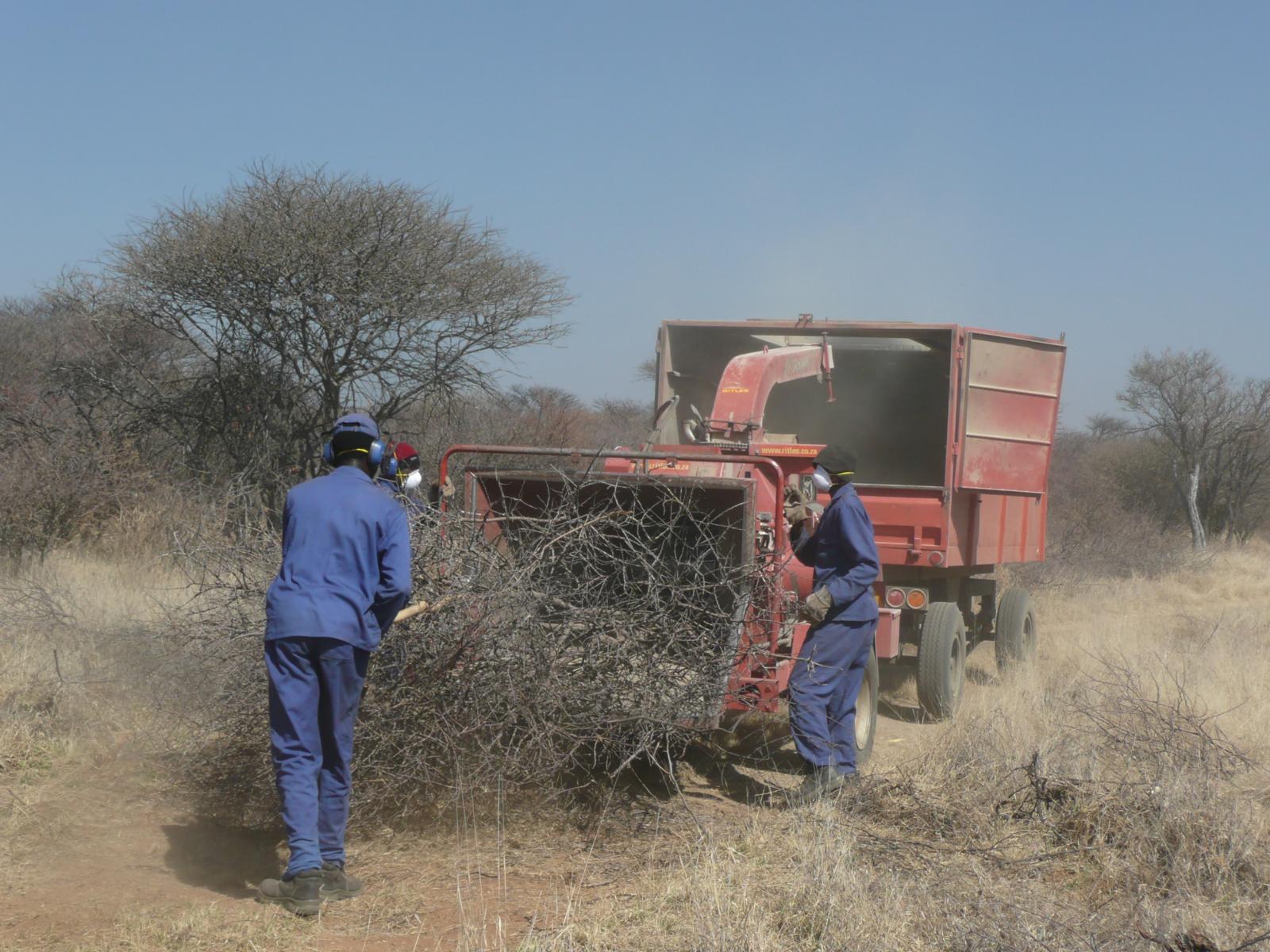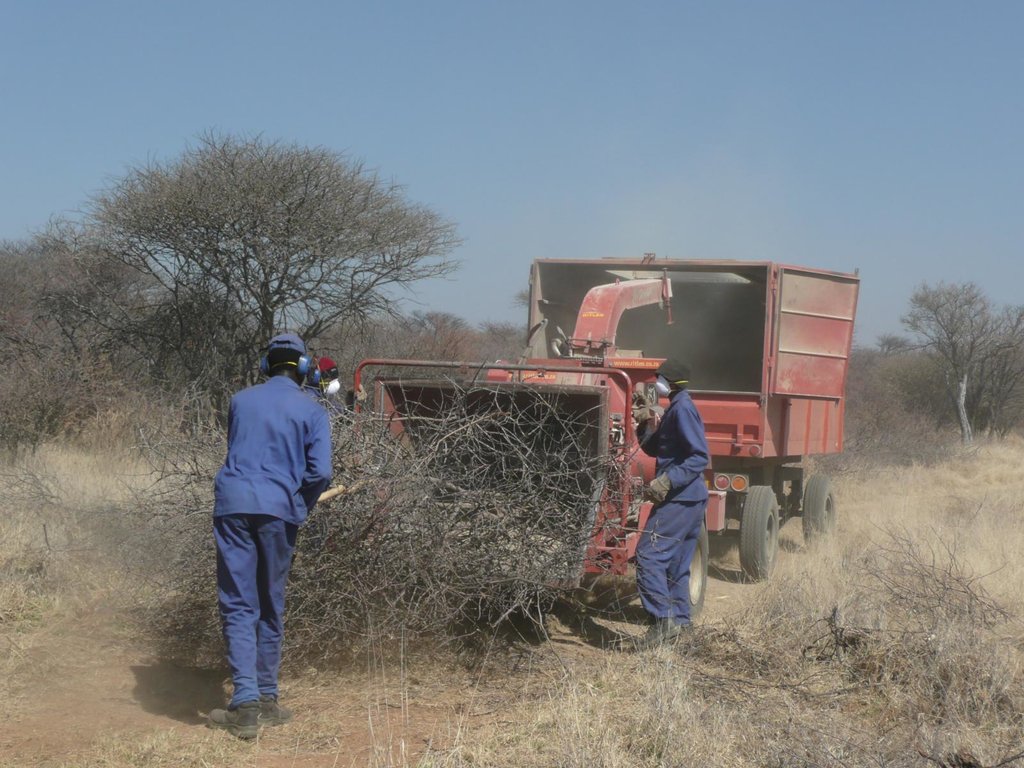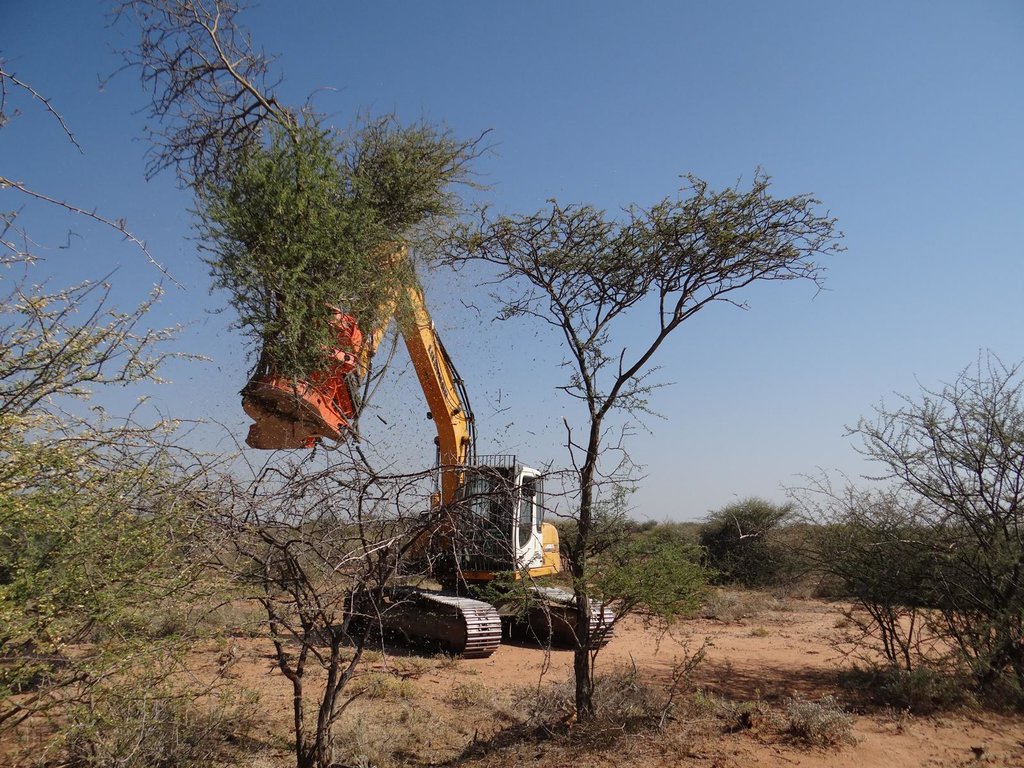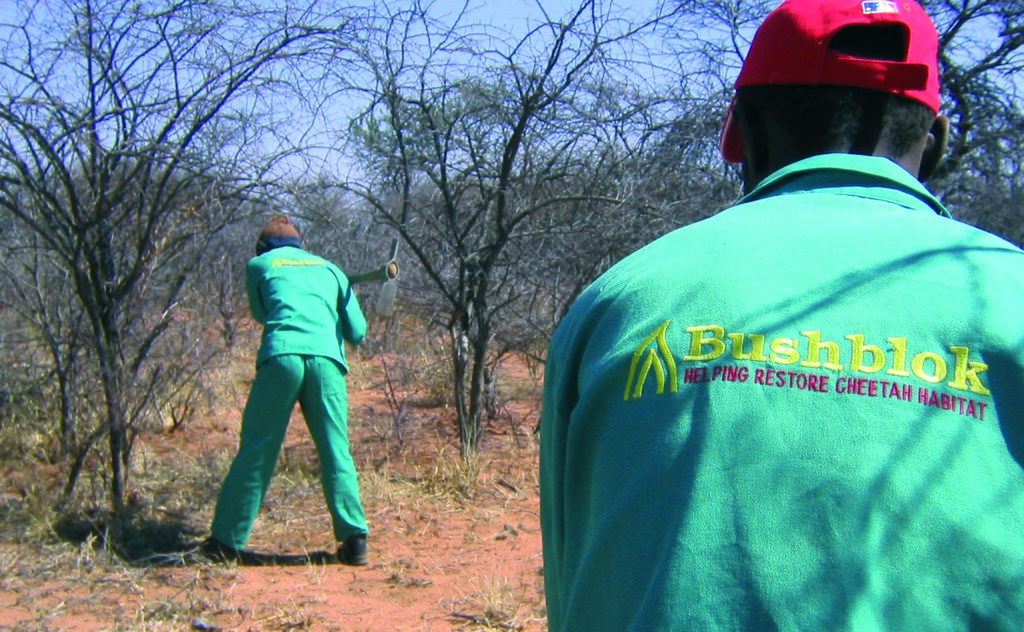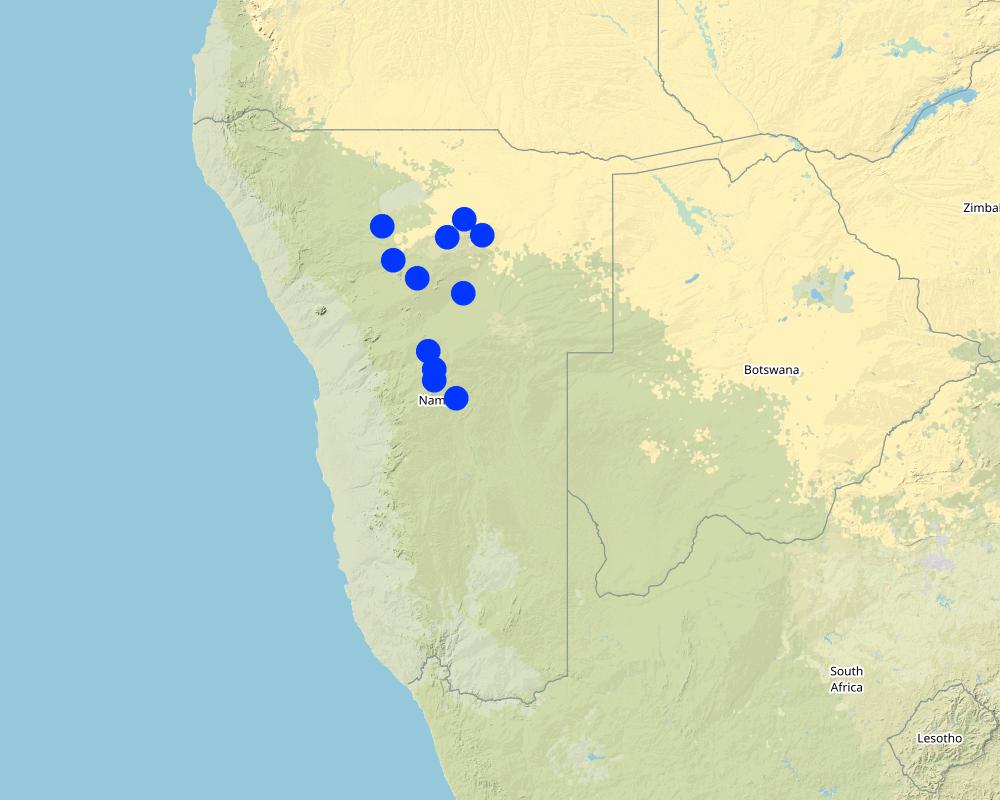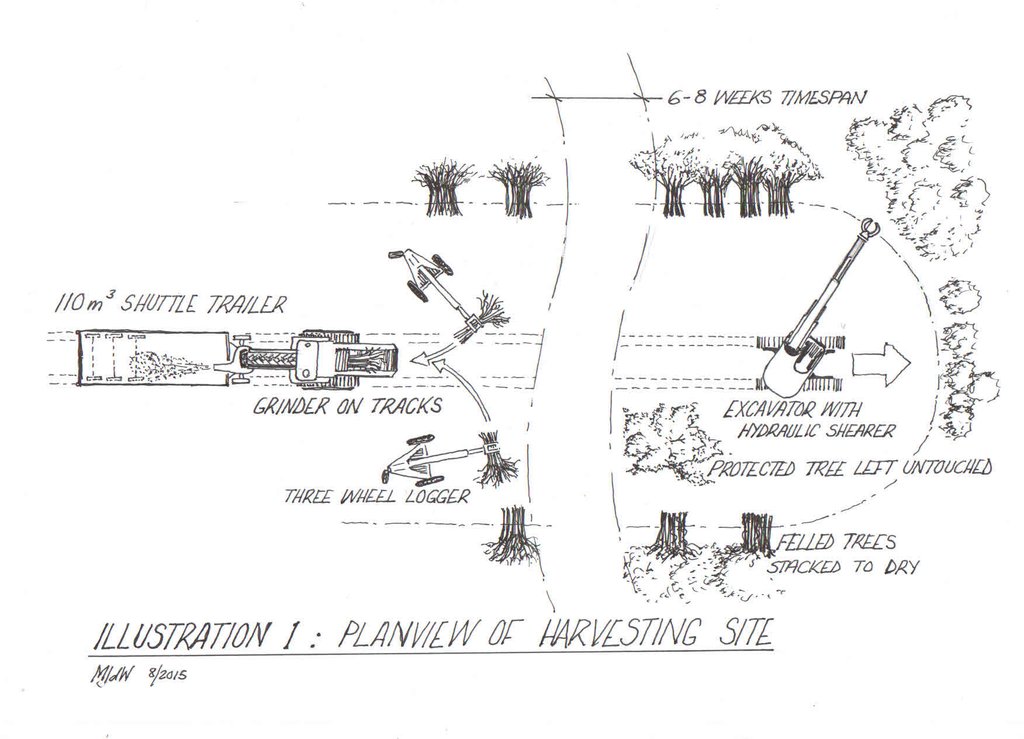Bush Thinning and Biomass Processing by Manual or Mechanised Means [Namibia]
- Creation:
- Update:
- Compiler: Johannes Laufs
- Editor: Asellah David
- Reviewers: Alexandra Gavilano, Rima Mekdaschi Studer, Simone Verzandvoort, Donia Mühlematter, Joana Eichenberger
Bush Thinning
technologies_2203 - Namibia
- Full summary as PDF
- Full summary as PDF for print
- Full summary in the browser
- Full summary (unformatted)
- Bush Thinning and Biomass Processing by Manual or Mechanised Means: July 17, 2018 (inactive)
- Bush Thinning and Biomass Processing by Manual or Mechanised Means: May 31, 2019 (inactive)
- Bush Thinning and Biomass Processing by Manual or Mechanised Means: Aug. 22, 2017 (inactive)
- Bush Thinning and Biomass Processing by Manual or Mechanised Means: Nov. 2, 2021 (public)
- Bush Thinning and Biomass Processing by Manual or Mechanised Means: Feb. 21, 2018 (inactive)
View sections
Expand all Collapse all1. General information
1.2 Contact details of resource persons and institutions involved in the assessment and documentation of the Technology
SLM specialist:
Gschwender Frank
Name of project which facilitated the documentation/ evaluation of the Technology (if relevant)
GIZ Support to De-bushing ProjectName of project which facilitated the documentation/ evaluation of the Technology (if relevant)
Book project: Guidelines to Rangeland Management in Sub-Saharan Africa (Rangeland Management)Name of the institution(s) which facilitated the documentation/ evaluation of the Technology (if relevant)
Deutsche Gesellschaft für Internationale Zusammenarbeit (GIZ)1.3 Conditions regarding the use of data documented through WOCAT
The compiler and key resource person(s) accept the conditions regarding the use of data documented through WOCAT:
Yes
1.4 Declaration on sustainability of the described Technology
Is the Technology described here problematic with regard to land degradation, so that it cannot be declared a sustainable land management technology?
No
Comments:
The technology described is a means to rehabilitate degraded rangeland. Through targeted harvesting of bushes, the bush density is reduced, allowing for better growth of grass.
2. Description of the SLM Technology
2.1 Short description of the Technology
Definition of the Technology:
In Namibia, excess bush is harvested to reduce competition with other plants, especially grasses. Bush can be thinned manually (e.g. with axes), semi-mechanised (e.g. chainsaws) or fully mechanised (e.g. customised equipment). After cutting, the bush is left to dry and then processed into chips or other products.
2.2 Detailed description of the Technology
Description:
Bush thinning is carried out in Namibia to restore degraded rangeland by stimulating the re-growth of grasses – which are suppressed by excess bush. About 30-45 million hectares are affected by bush encroachment, and this affects biodiversity, groundwater recharge and the carrying capacity of rangeland. There are many causes of bush encroachment, including overgrazing and reduced frequency of wildfires. Most bush encroachment involves indigenous, rather than invasive, species.
While natural transitions in the ecosystems may lead to reductions in bush encroachment, active rehabilitation measures are required for the short-term improvements. This is an absolute necessity for many farmers, who experience severe economic difficulties due to the reduced productivity of their rangeland.
Bush control comprises responsive measures (bush thinning), follow-up measures (aftercare) as well as preventative measures (good rangeland management). Since vast areas of Namibian rangeland are heavily encroached by bush, the focus is currently on bush thinning. This entails selective harvesting of bush. To determine the density of bush remaining after thinning, a formula based on tree equivalent (TE) and average annual rainfall is used. One TE is defined as a woody tree or bush of 1.5 metres in height.
As rule of thumb for attaining optimal bush density, about 30-35% of encroacher biomass should be removed. This is based on research carried out mainly in South Africa, measuring and comparing the re-growth after bush removal. Where too much bush was removed, this often resulted in even heavier encroachment.
Bush thinning follows strict environmental guidelines set by the Directorate of Forestry (DoF) through the Forestry Act and the Directorate of Environmental Affairs (DEA) through the Environmental Management Act. This governs the equipment used (to avoid soil disturbance) and the amount of bushes harvested (to achieve a healthy number of the desired bush species). The amount of bushes to be harvested is determined by an expert and depends on various factors.
While there is a lack of precise knowledge on the long-term effect of bush thinning, there is no doubt that control has an overall positive effect on the savannah ecosystem in Namibia. The need is widely recognised among land owners and acknowledged on the national political agenda.
To render bush thinning economically feasible, value chains have been developed. Through processing and utilisation of the woody biomass, income can be generated. Processed bush biomass can, for example in the form of chips, can be used for thermal and electrical energy applications (e.g. local biomass power plants or biomass boilers for industry). Currently two such energy installations exist in Namibia, one at a local brewery and one at a local cement factory. In addition, the national power utility NamPower currently considers the construction of a 20-40 MW biomass power plant.
Other existing value chains include the production of charcoal, firewood, poles, as well as bush -based animal feed. Further value chains under consideration include composite materials, such as wood-plastic, as well as biochar.
Scientific observations have shown, that bush thinning requires regular follow-up. These measures (“aftercare”) include the prevention of coppicing and re-growth. This can be achieved by applying aboricides selectively to the cut stems, stem fires or the introduction of browsers (e.g. goats). Research on the effectiveness and possible side effects of each of these methods is limited.
A major challenge is the limited suitability of available machines. The process leads to high wear and tear on the equipment (both harvesting and processing technology, (like chippers and pelletisers), often rendering operations unprofitable. Research into, and development of, more suitable machinery is necessary. Other requirements are improved skills training and continuous monitoring of the long-term effects on rangeland.
2.3 Photos of the Technology
General remarks regarding photos:
All photos have either been taken by the GIZ Support to De-bushing Project or were provided to the project by third parties.
2.4 Videos of the Technology
Comments, short description:
https://www.youtube.com/watch?v=859GshR9hso&t=3s
Bush Encroachment in Namibia: Causes and Extent
An explanation of the root causes of bush encroachment and its impact on land in Namibia.
Date:
01/11/2015
Location:
Namibia
Name of videographer:
GIZ Support to De-bushing Project
Comments, short description:
https://www.youtube.com/watch?v=bmlzPDiqlxo&t=45s
Biomass Value Addition: Bush Based Products
An overview of existing and potential value chains based on encroacher bush.
Date:
01/11/2015
Location:
Namibia
Name of videographer:
GIZ Support to De-bushing Project
Comments, short description:
https://www.youtube.com/watch?v=MMSOfV2KBjA
Biomass Energy: From Bush to Electricity
Overview of the energetic applications of woody biomass from encroacher bush.
Date:
01/11/2015
Location:
Namibia
Name of videographer:
GIZ Support to De-bushing Project
2.5 Country/ region/ locations where the Technology has been applied and which are covered by this assessment
Country:
Namibia
Further specification of location:
Bush control is applied across Namibia on many privately owned farms. Activities are most concentrated in the regions Khomas, Omaheke, Otjozondjupa and Oshikoto.
Specify the spread of the Technology:
- evenly spread over an area
If the Technology is evenly spread over an area, specify area covered (in km2):
1200.0
If precise area is not known, indicate approximate area covered:
- 1,000-10,000 km2
Comments:
Pointers on the map only indicate points (e.g. urban centres) around which activities are concentrated. It is not possible to depict each site where bush control is implemented due to the high number of individual activities and projects.
Currently bush thinning is implemented on a total of approximately 120.000 hectares (1.200 km2) of farmland per annum. These activities are not confied to certain areas, but spread across all of Namibia, typically concentrating in the most encroached areas (e.g. Otjozondjupa, Khomas, Oshikoto and Omaheke regions).
Map
×2.6 Date of implementation
Indicate year of implementation:
2015
2.7 Introduction of the Technology
Specify how the Technology was introduced:
- through land users' innovation
- during experiments/ research
- through projects/ external interventions
Comments (type of project, etc.):
Since the 1950s the phenomenon of bush encroachment has been recognised by farmers in Namibia and counter measures have been implemented over the decades. The technologies applied largely relied on the means and innovative capabilities of the respective land owner. Only as of 2014, through the introduciton of a national Support to De-bushing Project, are technologies systematically researched and tested in the field.
3. Classification of the SLM Technology
3.1 Main purpose(s) of the Technology
- improve production
- reduce, prevent, restore land degradation
- conserve ecosystem
- preserve/ improve biodiversity
- create beneficial economic impact
3.2 Current land use type(s) where the Technology is applied

Grazing land
Extensive grazing:
- Ranching
Animal type:
- goats
- cattle
Comments:
Main animal species and products: Cattle, goats, game
Namibia is characterised by large commercial cattle farms. Du to its aridity the land is largely unsuitable for crop farming, with exceptions in high-rainfall areas such as the Grootfontein, Tsumeb, Otavi triangle.
The Northern parts of Namibia are managed as communal land, where farmers have lease holds for their land. In these areas a combination of millet production and cattle herding is common.
Number of growing seasons per year: 1
Livestock density: 284 000 in targeted area (105460km2) of bush thinning (Otjozondjupa region).
3.3 Has land use changed due to the implementation of the Technology?
Has land use changed due to the implementation of the Technology?
- Yes (Please fill out the questions below with regard to the land use before implementation of the Technology)
Comments:
The implementation of bush thinning allows to maintain the land use (e.g. cattle ranching) and is typically applied to increase productivity in the long-term.
3.4 Water supply
Water supply for the land on which the Technology is applied:
- rainfed
3.5 SLM group to which the Technology belongs
- pastoralism and grazing land management
- improved ground/ vegetation cover
3.6 SLM measures comprising the Technology

vegetative measures
- V4: Replacement or removal of alien/ invasive species

management measures
- M2: Change of management/ intensity level
- M5: Control/ change of species composition
3.7 Main types of land degradation addressed by the Technology

biological degradation
- Bh: loss of habitats
- Bq: quantity/ biomass decline
- Bs: quality and species composition/ diversity decline
3.8 Prevention, reduction, or restoration of land degradation
Specify the goal of the Technology with regard to land degradation:
- prevent land degradation
- restore/ rehabilitate severely degraded land
4. Technical specifications, implementation activities, inputs, and costs
4.1 Technical drawing of the Technology
Technical specifications (related to technical drawing):
Drawing of a bush harvesting site layout. The drawing depicts fully mechanised bush harvesting and immediate processing into wood chips. This set-up is most suitable for large-scale bush thinning, e.g. for the purpose of supplying biomass in larger quantities. Such off-take includes the potential export of bush in processed form (pellets) or energetic utilisation (e.g. local biomass power plants or biomass boilers in the industry). Currently two such energy solutions exist in Namibia, one at a local brewery and one at a local cement factory.
Note that a range of bush harvesting methods exist, ranging from fully mechanised (as depicted) to manual bush harvesting (e.g. with axes). The site layout and principles are the same in all scenarios, but harvesting speed and costs differ.
The bush harvesting process:
Bushes are harvested selectively with and excavator, to which a hydraulic sheer cutter is attached. The biomass is stacked in rows and left for drying some six to eight weeks (depending on weather conditions). The biomass is then further processed with a chipper and collected with a trailer for further transport off the farm (e.g. to a biomass power plant or industrial off-taker). As a rule of thumb, one third of the standing biomass is removed, leaving two thirds standing. Harvesting starts with smaller plants and then moves to larger ones, cutting only plants with 15 centimetres of diameter or less (as per Namibian forestry regulations).
Author:
M.J. de Wet Pr. Eng., NRGen Advisors (Pty) LTD
Date:
18/09/2015
4.2 General information regarding the calculation of inputs and costs
Specify how costs and inputs were calculated:
- per Technology area
Indicate size and area unit:
1 hectare
other/ national currency (specify):
Namibia Dollar (NAD)
If relevant, indicate exchange rate from USD to local currency (e.g. 1 USD = 79.9 Brazilian Real): 1 USD =:
0.078
Indicate average wage cost of hired labour per day:
Namibia Dollar (NAD) 110
4.3 Establishment activities
| Activity | Timing (season) | |
|---|---|---|
| 1. | Bush harvesting/felling | Year around |
| 2. | Stacking (and drying) | Year around |
| 3. | Feeding the chipping operation | Year around |
| 4. | Transport | Year around |
Comments:
The restorative measure includes bush harvesting/felling as well as aftercare measures. Additional activities include the processing (e.g. into chips) and transport of the woody material off the farm/land.
4.4 Costs and inputs needed for establishment
| Specify input | Unit | Quantity | Costs per Unit | Total costs per input | % of costs borne by land users | |
|---|---|---|---|---|---|---|
| Labour | 1 x Mechanic | person days | 0.2 | 2000.0 | 400.0 | |
| Labour | 4 x Operators | person days | 0.8 | 300.0 | 240.0 | |
| Labour | 1 x Operation manager chipping | person days | 0.2 | 1000.0 | 200.0 | |
| Labour | 1 x Chipping operator | person days | 2.0 | 150.0 | 300.0 | |
| Equipment | 1 x 12t Excavator | pieces | 1.0 | 120.0 | 120.0 | |
| Equipment | 2 x Hydraulic grab and shearing attachments | pieces | 2.0 | 60.0 | 120.0 | |
| Equipment | 2 x Three wheel loggers | pieces | 2.0 | 180.0 | 360.0 | |
| Equipment | 1 x Chipper | pieces | 1.0 | 840.0 | 840.0 | |
| Other | Management and administration overhead | lump sum | 1.0 | 200.0 | 200.0 | |
| Other | 12.0 | |||||
| Total costs for establishment of the Technology | 2780.0 | |||||
| Total costs for establishment of the Technology in USD | 35641.03 | |||||
Comments:
Cost of bush harvesting can be calculated per hectare (e.g. land owner's perspective) or per tonne (in fuel supply agreements with off-takers). All given costs are approximations, as costs vary widely depending on the local framework conditions on a given piece of land. Typically the costs to harvest and process bush on one hectare range from 2,000 NAD to 4,000 NAD.
4.5 Maintenance/ recurrent activities
| Activity | Timing/ frequency | |
|---|---|---|
| 1. | Aftercare | Annually |
Comments:
When land is thinned it creates a vacuum in which weeds and woody plants (sometimes more aggressive colonisers than the original encroacher species) will quickly establish themselves. Regular aftercare needs to be applied in order to prevent the excessive re-growth of bush (and therewith new degradation of the land). Various methods are in use to manage the re-growth of bush following harvesting. These include selective application of arboricides, stem burning, and intensive browsing by goats or antelopes.
The more sustainable the bush harvesting itself has taken place, importantly not completely clearing larger areas of vegetation, the less likely is agressive re-growth of bush. In all bush thinning exercises it is important to leave larger bushes and trees untouched and to start by removing the smaller, less established bushes. In addition, not only individual larger bushes must be left standing, but also islands/patches of bushes, which fulfill important ecosystem services, e.g. habitat for animals.
4.6 Costs and inputs needed for maintenance/ recurrent activities (per year)
If you are unable to break down the costs in the table above, give an estimation of the total costs of maintaining the Technology:
500.0
Comments:
Commonly aftercare is applied in form of manual application of herbicides to the cut stems, in order to prevent re-growth of the bushes.
4.7 Most important factors affecting the costs
Describe the most determinate factors affecting the costs:
(1) Investment in machinery (if not applied manually).
(2) Maintenance of machinery (high wear and tear due to hardness of wood and high mineral content).
(3) Remoteness of farms/land from buyers/markets.
5. Natural and human environment
5.1 Climate
Annual rainfall
- < 250 mm
- 251-500 mm
- 501-750 mm
- 751-1,000 mm
- 1,001-1,500 mm
- 1,501-2,000 mm
- 2,001-3,000 mm
- 3,001-4,000 mm
- > 4,000 mm
Specify average annual rainfall (if known), in mm:
350.00
Specifications/ comments on rainfall:
Namibia is a semi-arid country and rainfall ranges roughly from 150-550 mm per year (rough approximation due to the vastness of the area described).
Indicate the name of the reference meteorological station considered:
Various
Agro-climatic zone
- semi-arid
5.2 Topography
Slopes on average:
- flat (0-2%)
- gentle (3-5%)
- moderate (6-10%)
- rolling (11-15%)
- hilly (16-30%)
- steep (31-60%)
- very steep (>60%)
Landforms:
- plateau/plains
- ridges
- mountain slopes
- hill slopes
- footslopes
- valley floors
Altitudinal zone:
- 0-100 m a.s.l.
- 101-500 m a.s.l.
- 501-1,000 m a.s.l.
- 1,001-1,500 m a.s.l.
- 1,501-2,000 m a.s.l.
- 2,001-2,500 m a.s.l.
- 2,501-3,000 m a.s.l.
- 3,001-4,000 m a.s.l.
- > 4,000 m a.s.l.
Indicate if the Technology is specifically applied in:
- not relevant
5.3 Soils
Soil depth on average:
- very shallow (0-20 cm)
- shallow (21-50 cm)
- moderately deep (51-80 cm)
- deep (81-120 cm)
- very deep (> 120 cm)
Soil texture (topsoil):
- coarse/ light (sandy)
Soil texture (> 20 cm below surface):
- coarse/ light (sandy)
Topsoil organic matter:
- low (<1%)
5.4 Water availability and quality
Ground water table:
5-50 m
Availability of surface water:
poor/ none
Water quality (untreated):
good drinking water
Is water salinity a problem?
No
Is flooding of the area occurring?
No
5.5 Biodiversity
Species diversity:
- low
Habitat diversity:
- medium
5.6 Characteristics of land users applying the Technology
Sedentary or nomadic:
- Sedentary
Market orientation of production system:
- commercial/ market
Off-farm income:
- less than 10% of all income
Relative level of wealth:
- average
Individuals or groups:
- individual/ household
Level of mechanization:
- mechanized/ motorized
Gender:
- women
- men
Age of land users:
- middle-aged
5.7 Average area of land used by land users applying the Technology
- < 0.5 ha
- 0.5-1 ha
- 1-2 ha
- 2-5 ha
- 5-15 ha
- 15-50 ha
- 50-100 ha
- 100-500 ha
- 500-1,000 ha
- 1,000-10,000 ha
- > 10,000 ha
Is this considered small-, medium- or large-scale (referring to local context)?
- large-scale
Comments:
Typical commercial farm size is 5.000 ha. The size increases with decreasing rainfall (towards southern Namibia).
5.8 Land ownership, land use rights, and water use rights
Land ownership:
- individual, titled
Land use rights:
- individual
Water use rights:
- individual
5.9 Access to services and infrastructure
health:
- poor
- moderate
- good
education:
- poor
- moderate
- good
technical assistance:
- poor
- moderate
- good
employment (e.g. off-farm):
- poor
- moderate
- good
markets:
- poor
- moderate
- good
energy:
- poor
- moderate
- good
roads and transport:
- poor
- moderate
- good
drinking water and sanitation:
- poor
- moderate
- good
financial services:
- poor
- moderate
- good
6. Impacts and concluding statements
6.1 On-site impacts the Technology has shown
Socio-economic impacts
Production
fodder production
Comments/ specify:
Bush-based animal feed production has been successfully trialed and is implemented by various farmers across Namibia.
animal production
Comments/ specify:
Carrying capacity of bush controlled land increases if regular aftercare is implemented.
energy generation
Comments/ specify:
Bush-to-electricity value chain under development. Several industrial off-takers use woody biomass for boilers (heat), the national power utility currently develops a first biomass power plant.
Water availability and quality
water availability for livestock
Comments/ specify:
Studies show a direct positive correlation between the extent of bush control and the availability of groundwater.
Income and costs
farm income
Comments/ specify:
Bush based value addition, e.g. charcoal production, leads to additional income for land owners and farm workers.
diversity of income sources
Comments/ specify:
Bush based value addition, e.g. charcoal production, leads to additional income for land owners and farm workers.
Ecological impacts
Biodiversity: vegetation, animals
biomass/ above ground C
plant diversity
invasive alien species
Comments/ specify:
Alien species are completely removed where possible (e.g. Prosopis).
6.3 Exposure and sensitivity of the Technology to gradual climate change and climate-related extremes/ disasters (as perceived by land users)
Gradual climate change
Gradual climate change
| Season | increase or decrease | How does the Technology cope with it? | |
|---|---|---|---|
| annual rainfall | decrease | not well |
Climate-related extremes (disasters)
Climatological disasters
| How does the Technology cope with it? | |
|---|---|
| drought | not well at all |
Comments:
Despite only limited research exists, long periods of drought that the country has recently faced, are credited to climate change. Drought intensifies the challenge for farmers, as already degraded rangeland has limited capacity to recover in the absence of rain. The technology of bush thinning itself has limited effect if no rain follows the removal of bushes.
6.4 Cost-benefit analysis
How do the benefits compare with the establishment costs (from land users’ perspective)?
Short-term returns:
negative
Long-term returns:
very positive
How do the benefits compare with the maintenance/ recurrent costs (from land users' perspective)?
Short-term returns:
negative
Long-term returns:
very positive
Comments:
Bush thinned land takes 3-5 years to fully recover its productive grass layer, thus direct economic benefits are only experienced with a delay.
6.5 Adoption of the Technology
- single cases/ experimental
If available, quantify (no. of households and/ or area covered):
120'000 hectares are bush thinned per year in Namibia; figures on the increase
Of all those who have adopted the Technology, how many did so spontaneously, i.e. without receiving any material incentives/ payments?
- 51-90%
Comments:
Farmers largely implement bush control on their own initiative; increasingly value chains are being developed and dedicated service providers offer bush control.
6.6 Adaptation
Has the Technology been modified recently to adapt to changing conditions?
Yes
If yes, indicate to which changing conditions it was adapted:
- changing markets
Specify adaptation of the Technology (design, material/ species, etc.):
Increasingly bush harvesting is carried out with mechanised means, aiming at large scale production for large biomass off-takers, both in the country and internationally.
6.7 Strengths/ advantages/ opportunities of the Technology
| Strengths/ advantages/ opportunities in the land user’s view |
|---|
| Effective measure against bush encroachment |
| Costs can be balanced with additional income through the sale of the biomass/biomass based products |
| Strengths/ advantages/ opportunities in the compiler’s or other key resource person’s view |
|---|
| Apart from the main purpose of rehabilitating rangeland, bush control has various side benefits, such as employment creation and industrialisation. |
| Bush control and biomass utilisation can contribute to energy security in the country. |
| The available range of technologies (from manual to fully mechanised) allows to develop viable concept for all types of land/land ownership scenarios. |
6.8 Weaknesses/ disadvantages/ risks of the Technology and ways of overcoming them
| Weaknesses/ disadvantages/ risks in the land user’s view | How can they be overcome? |
|---|---|
| High initial costs involved. | Development of dedicated financial products. |
| Possible negative consequences, such as more aggressive re-growth of species. | Increased knowledge dissemination, skills development and mentorship programmes. |
| Weaknesses/ disadvantages/ risks in the compiler’s or other key resource person’s view | How can they be overcome? |
|---|---|
| Necessity of cross-sector collaboration, e.g. agriculture, forestry, environment, industry, energy and resulting complexity. | Introduction of effective steering body on national level. |
| Challenges to sustain operations in communal areas/on land that is not owned by individuals. | Development of concepts for community based projects and cooperation with relevant regional authorities and decision making bodies (e.g. Regional Councils, Conservancies). |
7. References and links
7.1 Methods/ sources of information
- field visits, field surveys
De-bushing Advisory Service Demand Survey (2015), 361 respondents
- compilation from reports and other existing documentation
Various
When were the data compiled (in the field)?
01/08/2014
7.2 References to available publications
Title, author, year, ISBN:
Baseline Assessment for De-bushing Programme in Namibia (2014)
Available from where? Costs?
GIZ Support to De-bushing Project, www.dasnamibia.org/downloads
Title, author, year, ISBN:
Demand Survey for the implementation of a De-bushing Advisory Service (2015)
Available from where? Costs?
GIZ Support to De-bushing Project, www.dasnamibia.org/downloads
Title, author, year, ISBN:
Value Added user-opportunities for encroacher bush (2015)
Available from where? Costs?
GIZ Support to De-bushing Project, www.dasnamibia.org/downloads
Title, author, year, ISBN:
Compendium of harvesting technologies for encroacher bush (2015)
Available from where? Costs?
GIZ Support to De-bushing Project, www.dasnamibia.org/downloads
Title, author, year, ISBN:
Assessment of biomass resource and potential yield in Namibia (2015)
Available from where? Costs?
GIZ Support to De-bushing Project, www.dasnamibia.org/downloads
Title, author, year, ISBN:
Strategic Environmental Assessment (SEA) on bush thinning and biomass utilisation (2015)
Available from where? Costs?
GIZ Support to De-bushing Project, www.dasnamibia.org/downloads
Title, author, year, ISBN:
Assesment of financial products and incentive schemes for bush harvesting and value addition (2015)
Available from where? Costs?
GIZ Support to De-bushing Project, www.dasnamibia.org/downloads
Title, author, year, ISBN:
Environmental and forestry bush harvesting guidelines and generic Environmental Management Plan (2016)
Available from where? Costs?
GIZ Support to De-bushing Project, www.dasnamibia.org/downloads
Title, author, year, ISBN:
Regional assessment of the economics of land degradation related to bush encroachment in Otjozondjupa, Namibia
Available from where? Costs?
GIZ Support to De-bushing Project, www.dasnamibia.org/downloads
7.3 Links to relevant online information
Title/ description:
De-bushing Advisory Service (DAS) Namibia, Resource Section
URL:
www.dasnamibia.org/downloads
Title/ description:
Namibia Biomass Industry Group (N-BiG)
URL:
www.n-big.org
Title/ description:
Videos
URL:
https://www.youtube.com/channel/UCwCICCfwf0SdVBqg2ZcAcKA
Title/ description:
Namibia Charcoal Association (NCA)
URL:
www.ncanamibia.com
Links and modules
Expand all Collapse allLinks
No links
Modules
No modules


